|
Thought I'd try this once, and see how it came out. Hopefully the volume came out OK, so you can get the coaching points as I run the video.
0 Comments
For many coaches, there is no "OFF SEASON" -- conditioning and strength programs are in full swing, and many programs will implement QB School before team-wide football activities will take place. Along those lines, I thought I would list a few bullet points: Feeding a great player - having a specialized section in the game plan is nothing new; one thing I feel is important is that these methods should blend with the regular flow of the offense. In other words, re structuring an entire system just to feature a single player is not the most efficient way to teach for the program's sake. Obviously, if one were lucky enough to have a once-in-a-lifetime talent, one would want to take advantage of that. However, a player can be GREAT for your level without being an NFL prospect. Below, a simple variation to free up a great run after the catch RB is shown with a complete pattern that is a staple of the offense. Taking the same example of passing game match-ups with the back, we can augment the backside of STICK, taking advantage of W on an island: Formationing to create stress on the defense - this is potentially the least expensive way to maximize your offensive attack. Two things that need to be addressed are: - The method for calling plays. If the method for play calling calls for players to know their place in the formation relative to the ball (ex. inside, middle, outside), and there is NOT a descriptive way to call them, this can create chaos. If the plan to take advantage of a great player is to move him around within the formation, the coach must consider the learning burden not only to the star player, but to the players that will be displaced as a result. The ability to move people within a given formation with minimal learning burden is yet another example of the benefits of our terminology structure. The above example isn't the only way to skin a cat; a client approached me this year of incorporating A.C.T.S. into their passing game. We were able to do so without changing ANY existing terminology for them. Whether using word or numbers -- how the core pieces of the passing game are taught remain the same, and kids are able to execute a multi-dimensional attack. - Creating new terminology to build new formations. I have always felt that streamlining the terms used can be of a great benefit. We have a terrific system of calling formations, that minimizes the memorization required at the same time. Keith Grabowsky has also shared some great ideas here. For now, here are the very simple alignment rules we use: The chart above carries across all personnel groupings, and really cuts down the verbiage used in calling formations, allowing for more description in other parts of the call, and allowing for the next bullet point... The use of TEMPO - much has been said on this topic, but I feel the need to clarify a few things. We're all aware of the flashy, video game number-producing, throw it all over the park offense that gets all the media attention. But the reality is that upper level college football is pretty much the only place where teams can play full throttle the entire game and NOT hurt the rest of the team. Either that, or a program like the one I see every Friday night (Allen High School has an enrollment of 6,000+). Even Chip Kelly adjusted last season as his numbers dictated that he do so. That being said, I think analysts often miss the purest advantages of being up tempo from a coach's perspective: - Accelerated player development. Being "up tempo" means devoting a practice philosophy to it (or at least - it should). Working at a faster pace in practice means developing younger players at a faster pace, as backups would get as many repetitions as the starter. In a high school setting, the ability to give the backup QB as many reps as the starter will pay dividends in both the immediate and long term future. - Allows for balance. Contrary to popular belief, I really am a proponent of balance. Even more important - I think an offense has to be able to dictate to the defense. The box count theory of running the ball is great, but the thing I have noticed is this: there is NO answer when you can run the ball right at a defense. The one problem with running it 30-40 times a game? It shortens the game too much, and can potentially let a team that is inferior STAY IN THE GAME. Being up tempo and wide open does not have to be synonymous with soft; below, we see that of the top 25 offenses in Division 1 last year, only 2 huddled on a regular basis. Furthermore, only 3 averaged less than 150 yards rushing per game. The ability to speed up and slow down the game help strike the critical balance between attacking mismatches and physically deconstructing a defense. - Allows for "Navigation Tags." Being able to guide the QB with specialized instruction is made possible when tempo is used as a weapon. I wrote a post about these tags here. - Shifting and Motion. Having played in a college offense that shifted and moved on every snap, I saw very early on in my career the potential for stressing a defense. If there was ever an opportunity to take advantage of shifting and motioning, a no huddle offense that varied its pace could take advantage. Being multiple, in addition to having the capacity to being up tempo, is invaluable in terms of creating stressors for the defense. In business terms, these methods can be thought of as the "delivery" side of the offense. Just as important is the production aspect -- the overall design. Prioritizing your passing game - not only is this pass offense built on its "bedrock" concepts, but it is based on universal individual routes as well. By teaching the primary components of the passing game to all position groups, there is an enormous amount of flexibility. One such route is a DRAG, with the drill illustration below: With every skill group able to execute these fundamental building blocks, we are able to use the DRAG in an array of presentations, giving the defense different problems to consider: Practicing what you preach - too often, we get away from developing a kid's strength, instead focusing on his weaknesses. At most levels of football, coaches cannot afford to do this. The best coaches I've known have maximized the potential of their players. For example, much is made of the pass-catching TE at the NFL level; while a kid may not be a Jimmy Graham, he could be and effective possession receiver, or even a solid seam threat vs. 3 deep. It becomes incumbent on the coach to dial up these match-ups, not as a means of appeasing the player, but as a means of accountability to the program -- the coach must be committed to what is best for the team. Sadly, I often see coaches who are not willing to be unselfish, yet ask players to do the very same.
Taking this a step further, from a team perspective, it is imperative to commit to the development of players. Development involves strategic planning on all levels of program and player development. My last two posts, here and here, address these processes. There is no doubt -- stability is the key to long term success; it is for this reason that a "system" needs to have all the answers, with as few "add-ons" as possible. The ability to adjust, while minimizing learning burden, can only be achieved with a methodical, well-planned apparatus for teaching. As many of you know, I played at The University of Texas; this year has been a very trying one for me. On one hand, I recognize the accomplishments of Mack Brown, and can tell you that I am sad the way things ended this year. I can tell you that he has been nothing but kind to me and my family, and that over sixteen years, the young men that played for him refer to him in only the most reverent terms. As a proud wearer of a "T Ring", I am grateful for the program he built, and am sure the next head coach has very big shoes to fill. I am eager for a few years to pass, so that Coach Brown will be remembered amongst the Burnt Orange fan base the way he should be. I am thankful not just for the thrilling victories the brought Texas, but for the kind of man who would send my niece a personalized note just because it was casually mentioned. For some reason, I have a hard time picturing many big-time football coaches doing the same. Because of my allegiance to people in the program, and because I know how coaching changes affect families, I will avoid speculation and rumor. I can only hope that the next staff will bring a along a track record for developing quarterbacks. It is no mistake that high-profile programs are often synonymous with difference makers at that position. And, it is also this author's belief that the best way to develop passers happens in a systematic manner. A multifaceted passing game must remain intact year in and year out; while individual talents will allow for expansion, the roots of the system should not change. In our QB Manual, we outline that a complete passing system must: · Give receivers the opportunity to defeat tight man coverage. · Prevent conflict between receivers. · Have a defined timing. · Stretch the defense vertically and horizontally. · Keep the QB out of interception danger. · Deny pattern reading by the defense. · Minimize one-for-one trades. · Keep receivers from free pass defenders. · Have a principle of route conversion. · Adjust to condensed field areas. · Have the ability to isolate certain parts of a pass defense. · Allow for quick throws when the defense is outflanked. · Accommodate delays and screens. · Have set reading concepts. · Have organized scramble rules. · Have the ability to adjust to multiple formations. Furthermore, a complete passing system must have a method for teaching not JUST patterns, but the moving parts within the patterns. For example, this pass offense is built off of 3 patterns (the drag, the streak read, and the stick) that form the foundation of the entire pass offense. Daily drills are designed to reinforce this teaching, and are combined with advantage principles to maximize effectiveness. Below, we see how a drill for option routes might be set up: Moreover, the method in regard to how plays are called is irrelevant. Whether word or numbers are used, the principles of teaching should be conceptual. In other words, individual routes need to be taught as part of a whole; whether a pattern is called 441 or CURL, the spacing and timing of how routes come open in relation to the passer's eyes are of paramount importance. In the illustration below, the progression desired is to work inside-out; this is a product of the timing of the patterns and how this timing is taught -- it is not a product of the nomenclature used. More than anything, the term CONCEPT refers to a way of thinking, rather than the distribution of receivers in a pattern. Take, for example, the STICK pattern. In the diagram below, the post is the advantage route; the stick/ flat (beginning with the flat) will be evaluated as the QB comes off the post, and the backside elements serve as the outlet receivers. Here, despite using the STICK pattern, the coach designs a pattern to attack away from the MLB's drop. With the ball on the left hash and the Mike dropping straight back, there is a lot of space to work S inside-out. Also note the outside receiver is instead given the responsibility of releasing outside the corner and driving him back. While the timing of individual routes remains constant, the language must exist to communicate the coach's intention's to his players; the 2 examples above show how CONCEPTS and PATTERNS can be two very different things. Having a language that can differentiate these two components is essential with today's no huddle environments. This language can also lead to development of players beyond just the top 1 or 2 QBs in a system.
How can this development occur? Like anything else, it begins with commitment. One of my clients has begun a project that not only involves the the high school and junior high programs, but the local youth programs as well. A system will be put in place, and the results will no doubt come thereafter. A SYSTEM FOR CREATING EMPTY SETS I have always been associated with multiple-formation offenses, and I view the ability to line up in a no-back set as a simple extension of this philosphy. We've developed nomenclature and rules that not only shorten formation names, but provide easy-to-grasp alignment terms as well. In order to align receivers, we use the following: Using the above terms, we can combine with terms that move our B (or his sub) to the following spots below: Using the above formula, we can incorporate POWER PLAYERS (TEs, H-Backs, FBs) into our empty package. Being able to jump in and out of these sets from different personnel groups (as part of a normal no-huddle attack) can stress a defense, as defensive calls must either be standardized or as part of a "check" package. Either way, a predictable response can give the offense an upper hand. The key remains having a system of formationing and play calling that eliminates NEW learning. From 1 TE/1 RB, the option route by the back is helpd by the stack. W is now a true "walkaway" player, and there is a greater chance to get into the space vacated as M goes strong. We use the RAM Advantage Principle here. The presence of 2 tight end bodies on the field often requires a defense to account for 7 gaps in the front, often leading to some type of 3 deep coverage. A basic pattern for us is shown below. Again, there is no new learning, based on the 3 route stems that are universally taught in the offense. Our TROJAN grouping features 4 WR and a TE/ H-Back. Not only can we run all our basic routes, like the DRIVE combination below, but the defense must also make some telling decisions. How will they handle 3 receivers away from a TE/FL set? This formation also gives the DIG on "LEVELS" a bigger body running the route - against the S linebacker instead of the W. Here, the M is removed even further to the three receivers, putting S on an Island. Best of all from this grouping, there is the possibility of 6 man protections. Many times, when the defense sees the running back leave the field, they will attack with a 6 man pressure or play zone with 3 down linemen. Below, we use the NUMBERS Advantage Principle to direct the passer to the best possible combination. If the defense responds by putting 3 down linemen on the field, the presence of the H back allows you to run QB power or zone; these plays can be run as a check package at the line -- once again taking advantage of being a no-huddle offense. Sometimes, EMPTY sets can benefit the passing game even when the defense goes with a 3 down front. Here, the offense uses empty to get a 3 down front and minimize the pass rush; it then uses sweep action to dislodge defenders in the way of the pattern. Once again, a basic pattern is used. HAVING A PURPOSE
The moral to the story is that EMPTY sets are an effective tool if used with a purpose. Like anything else, they can get a predicatble response from the defense, or create more space for a receiver (or runner). As discussed in my previous blog about gameplanning, there are also great ideas that can be gained from a protection aspect. When I put out my second book in late February, it was a departure from the terminology I used when I was coaching. As I had previously mentioned, the impetus was an attempt to create a structure so that little guys (like the one below) can start learning real passing structures, as opposed to the trick play fest (that, or 1-receiver routes) many teams will run at this age. While most of the feedback I got was overwhelmingly positive, there were some detractors, expressing concerns that the pass system was not simplified. All I have seen is proof to the contrary. Despite being as green as you could be (only 2 of our 11 kids have played organized football before this summer), the progress has been outstanding. With just one initial installation meeting, the rules, route tree, and backside tags used were introduced. I made parent participation mandatory (which also gives them ownership and understanding, curbing questions like "why won't you let my son play quarterback"), and the basic nomenclature was laid out using the same PowerPoints seen here. The assimilation has been astounding! We used 2 of the 3 Advantage Principles, and have installed the following possibilities backside: - Rule - Switch - Drag - Slide (we are calling "half" - as a 5 yard in is half of the basic 10 yard in - Beam/ Box (backside streak reads and switched streak reads) Over the course of summer 7 on 7, we'd hit all 4 different advantage routes for scores (Flag, Seam, Post, and Hook), as well as Wheel, Drag, and Switch routes. Even more astounding is the availability of the THIRD FIX -- the principle that allows us to attack the full width and depth of a pass defense. When a group of 8- and 9- year olds can digest this, it is hard to give credence to claims by a few who think the system presented is "too advanced for high school players." Moreover, I keep getting notes like the one below, from one of my clients in Ohio: "Two years ago my staff and I went on a search for an offensive system that would help incorporate all of our schemes into an organized pattern and read system. We were lucky enough to find Dan’s first book and implemented his stuff into our program for the 2012 season. We finished with an undefeated season and over 5000 yards of offense. We changed all language and didn’t miss a beat. It is that simple. This past off season Dan’s new book Recoded and Reloaded really brought things together. Dan’s new book is as comprehensive, thorough and simple as they get. We have been lucky enough to have 5 straight All Ohio Quarterbacks at our place over the past 10 seasons. We have had a tremendous amount of team and offensive success over the years. Some coaches feel you shouldn’t mess with successful schemes. We believe you should continue to find better ways to do the things you do well. I can say without reservation we found that in Dan’s new book. Our skilled players have a much better understanding of the offense and our Quarterback has a complete understanding of his reads and progressions. We decided to have Dan fly up to Cleveland and spend a weekend with our staff. Dan is fantastic to work with and the whole weekend was spent on the passing game. We did not have to gut our offense and start from scratch. We found, in Dan, a way to re –language everything and have the ability to add in any of the best schemes at any time. I can tell you this, we have had several years with 5000 or more yards in a 10 game season and I feel we are more explosive in the passing game than ever going into camp this season. How the system uses advantage routes as a first progression has proven invaluable. In addition, the backside route system is fantastic. I find myself hoping the advantage route and the concept are covered so we can get to the third fix!! I would recommend his book to anyone searching for a complete system. Lastly, I would recommend having Dan come see you and your staff as he is a fantastic teacher. Five months later he is sending updates and texts as he develops new things. Great stuff!!" Matt Duffy Head football Coach Willoughby South High School The further my clients get into the teaching phase of this pass system, the more convinced I am that this structure of calling pass plays is superior to what I did previously. Many coaches are hesitant to make such a leap (overhauling a system that had worked so well for so long), but I felt like it was an opportunity to offer the teams and coaches I work with a “catch-all” system of passing that could be taught to literally any level of player, but could also attack a defense with virtually any pattern structure. Likewise, high school teams that have switched to the system have reported a great ease in installation, and have added their feedback to improve the overall system in general. Because of the frontside tree (seen by some as too cumbersome), we are able to make adjustments that bring not only flexibility, but minimize learning burden as well. In this post, we'll look at some very inexpensive (from the offense's standpoint, in this way of teaching) adjustments to the "Big 3" patterns in this offense: Stick, Verticals, and Drive. We first examine STICK: The diagram above represents the way I learned the play, with the backside “Glance” or “Quick Post” providing an individual Advantage Route, discouraging defensive rotation over the Stick/ Flat combination. This setup, however, had a “point of no return” when the passer chooses the glance; if he chose incorrectly, there was no way to get back to the stick/ flat combo. However, if we deepen the depth of the Stick, giving a receiver more ability to adjust, we can now give the passer the best of both worlds: Further, with the rules built in to our system, we can alter the QB’s thought process, without the need for a Sideline discussion in between series: The 9 is NOT an individual Advantage Route, and we can tell adjust the Z’s route when we don’t need him to be on a post. Because the passer’s eyes will be inside, there is no need for a post. Because of the system, we can adjust a receiver’s assignment without burdening memorization. Another example of a situation specific adjustment could feature this pattern in anticipation of tight man coverage: Another nifty adjustment that takes advantage of a team’s gifted option-route runner is seen below. Using the RAM principle, the W is always in a bind. A complete write up on this can be found. We are also able to incorporate the option route from 3-1 sets, utilizing the option route described above and mating it with the popular “Y Cross” pattern: Though this pattern isn’t technically a member of the vertical game, I included it in this article to give an example of how to attack a specific response by a defense. The changeup above specifically attacks a pass defense’s attempt to cover up the 3x1 Four Vertical pattern, with M and F riding the #3 and the S walling off the #2 receiver: Once again, our system can help a QB navigate the murky waters of a pass defense, and use Streak Read adjustments to or away from the 3 receivers. Keep in mind that the streak read is a univeral route in this system; the core routes of the offense are taught to all position groups so that there is no new learning when making such an adjustment. We are also able to “slow down” the locked seam for the QB, and try to manipulate the S who is taught to wall #2, once again with no added learning burden: This method of re-distributing rules on the backside also greatly aided the DRIVE pattern; the utilization of a THIRD FIX of the passer’s eyes frequently finds a receiver the defense cannot account for. Getting the ball to a drag route in a vacated flat area is a primary goal of the DRIVE pattern. Once again, we are able to attack defensive responses without increased learning burden, and without changing the picture for the QB: DOT is a tag that stands for "Drag with an Outside Two;" the "2" route enters the area that was previously occupied by the back. Since we are wheeling him to the frontside, this a cheap, easy way of creating the same look for the QB.
|
AuthorLiving in Allen, TX and using this outlet to not only stay close to the game I love, but to help pass on what I have learned from some of the game's great coaching minds. Categories
All
Archives
July 2021
|

|
|
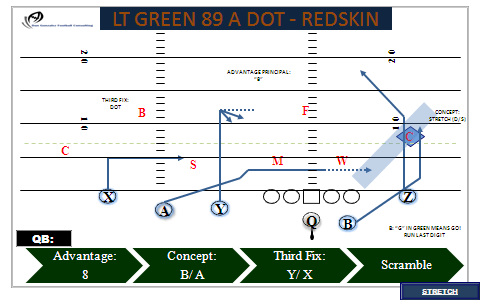
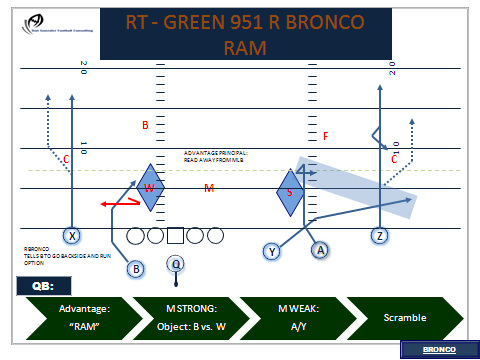
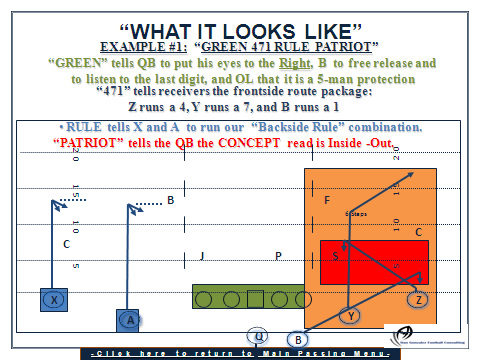
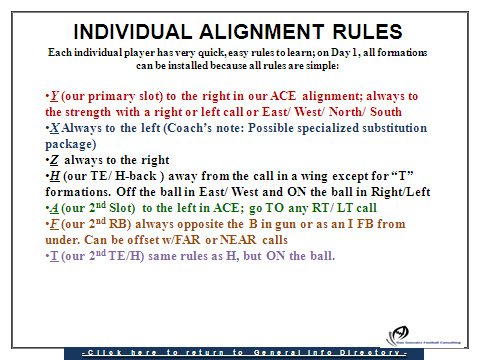
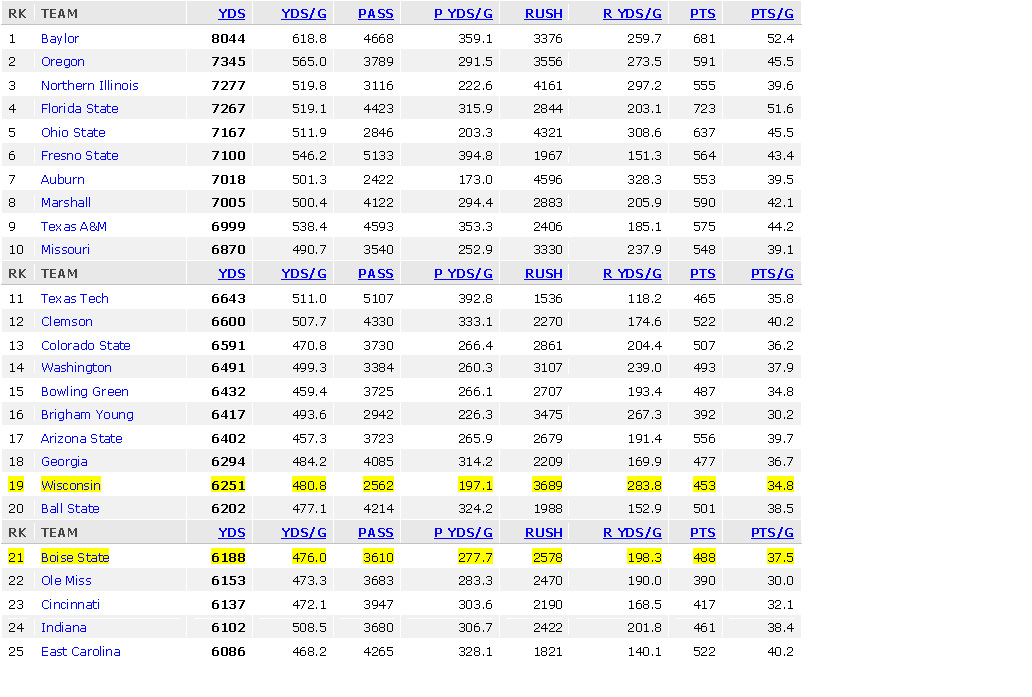
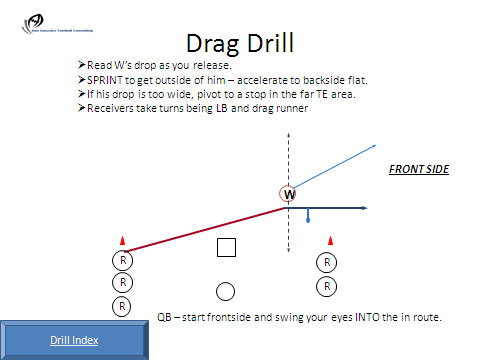
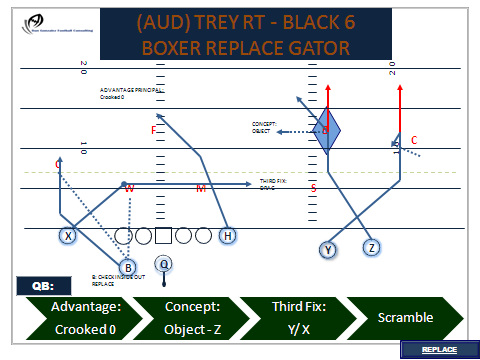
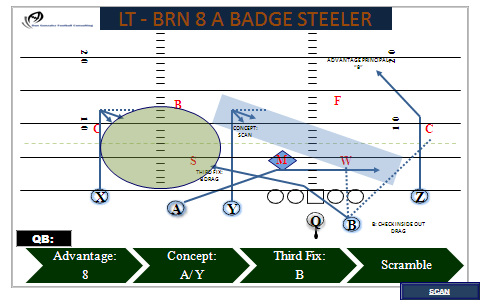


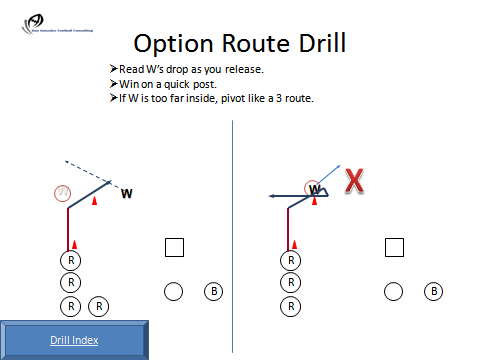
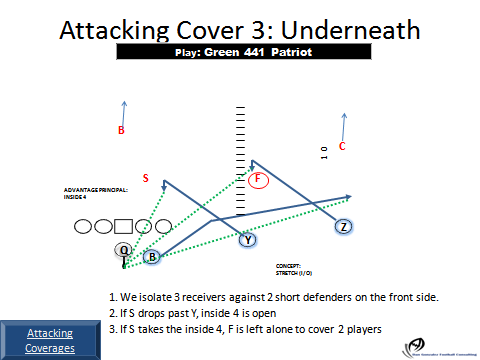
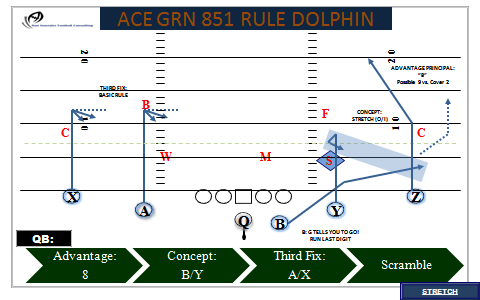
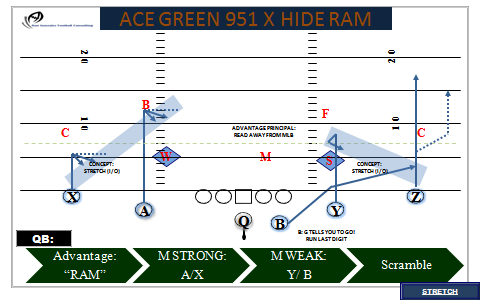

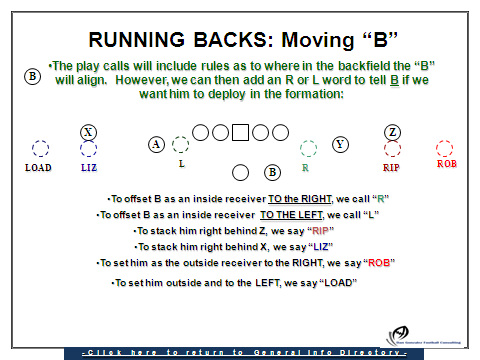
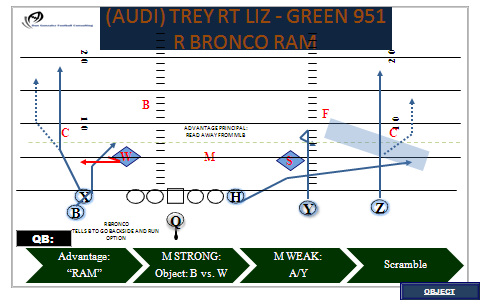

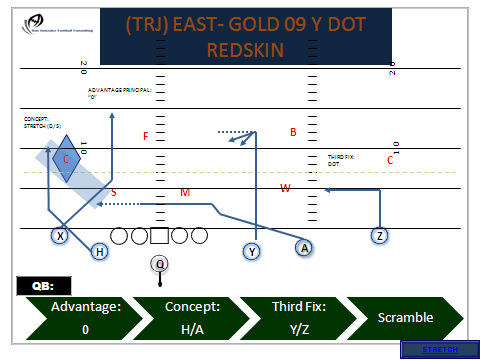
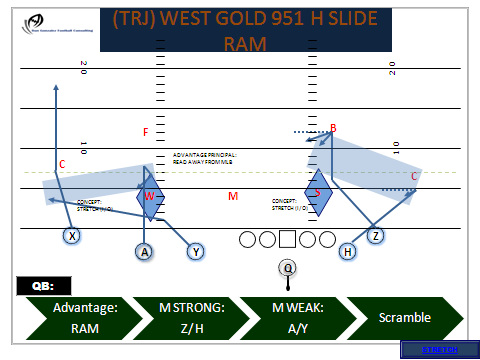
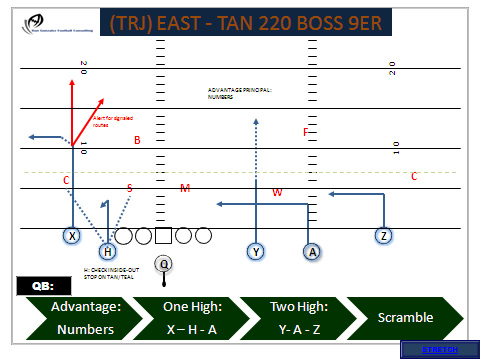
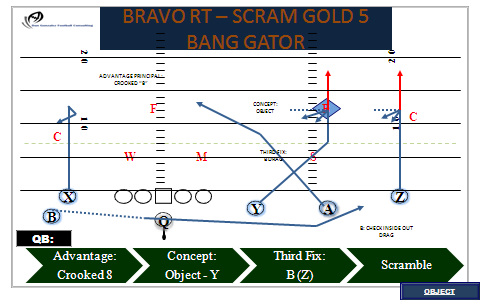
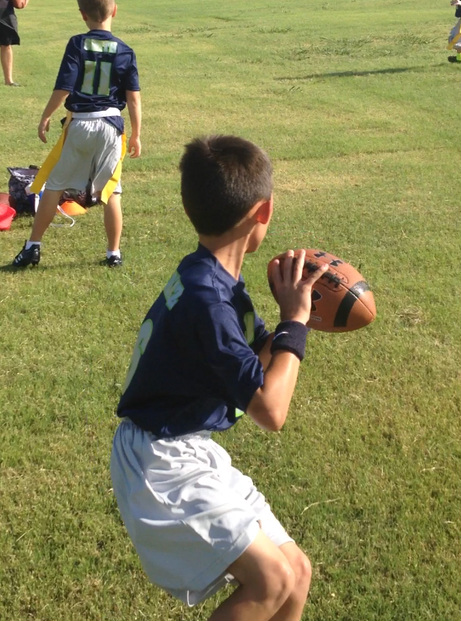
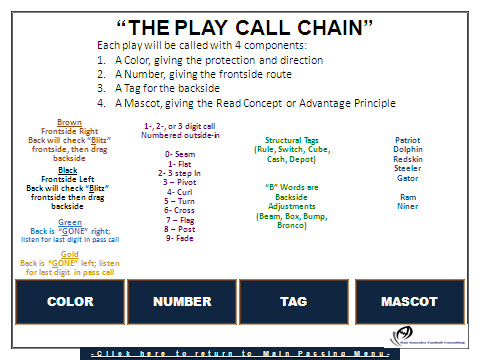
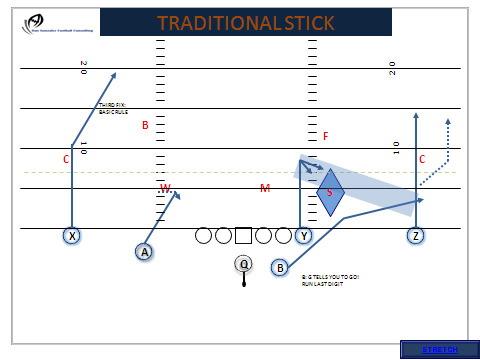
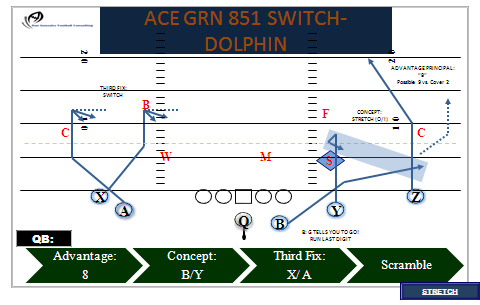
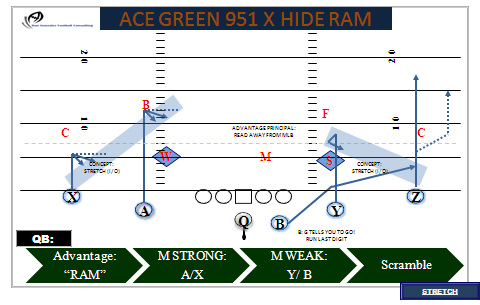
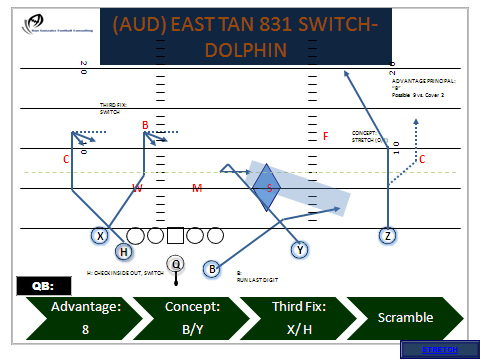
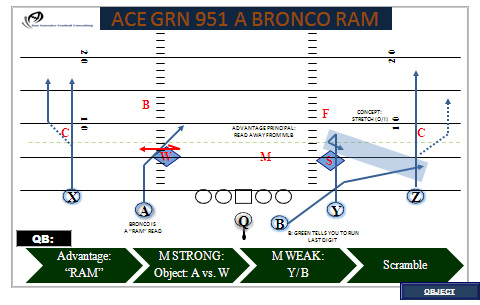
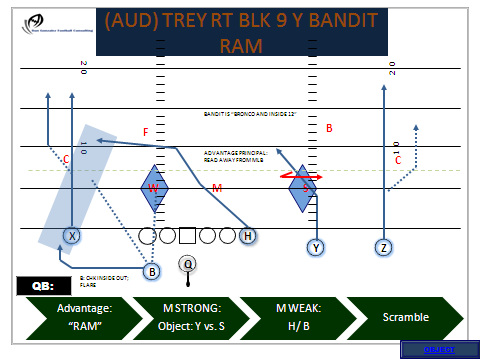
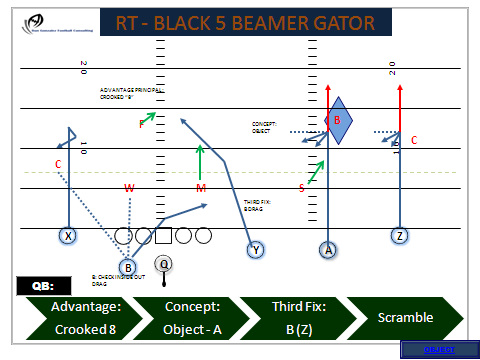
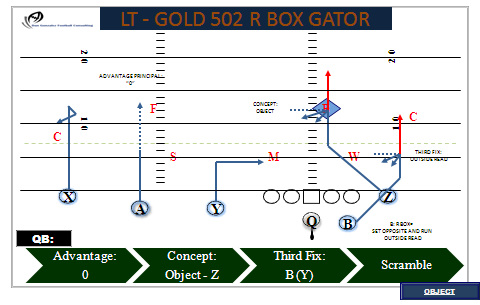
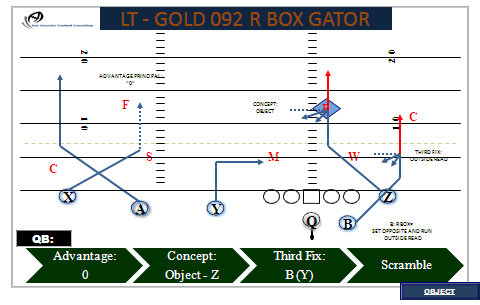
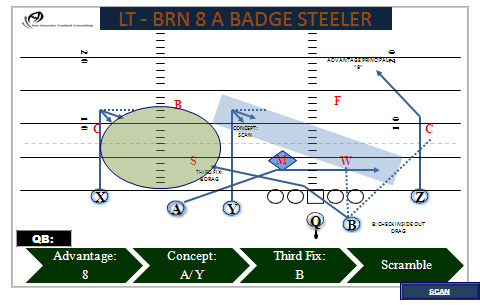
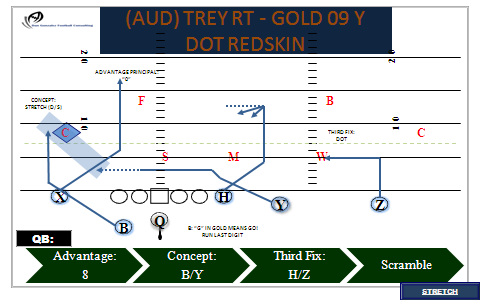

 RSS Feed
RSS Feed
